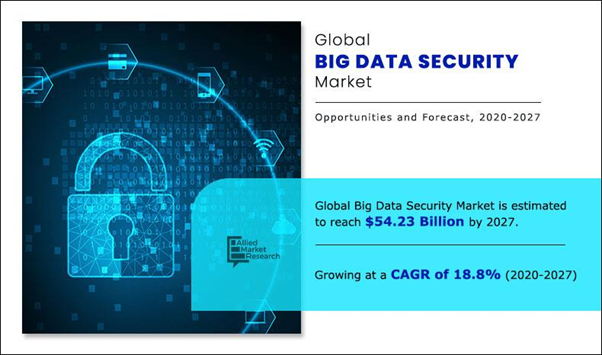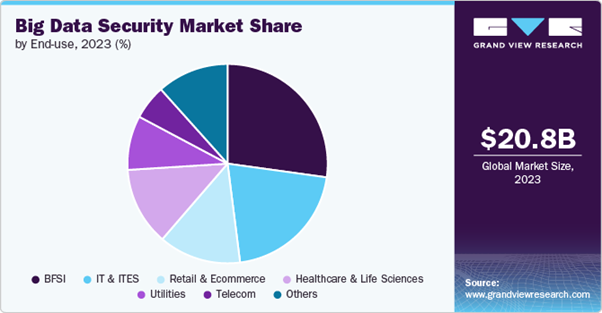Securing the Future: Big Data Security Market Poised for Explosive Growth

The question is no longer whether or not data needs to be protected; it's how quickly we can do it in today's highly connected world. Every click, swipe, and digital exchange leaves a data trail.
The market for big data protection was once a small niche area, but it's about to grow very quickly. Analysts all over the world are sounding the warning and spotting the chance. The need to protect data from threats, insider leaks, and legal mistakes grows as the amount, variety, and speed of data increases.
The Data Explosion: Blessing or Burden?
We make about 1.7 MB of data every second for every person on the world. Data is the new oil. It includes everything from medical records and bank transactions to government information and patterns of how people use the internet. But data is much more likely to be lost than oil. When you have a lot of information, you need to be responsible.
Even though there has been a huge increase, organisations have been slow to catch up. A lot of people still don't think about data protection until there is a breach.
Cyberattacks Are Evolving - and So Are the Stakes
In the past few years, there has been an alarming rise in complex hacking. Data breaches are no longer the work of lone hackers in basements. Now, they are planned by well-funded groups, often for global r easons. Not only are ransomware attacks, supply chain flaws, and zero-day bugs becoming more common, they are also getting a lot more accurate.
As an example, IBM says that the average cost of a data breach around the world hit $4.45 million in 2023. That number is a wake-up call. When businesses don't invest in strong big data security frameworks, they're basically taking a chance with their customers' trust, their finances, and their brand image.

Market Forecast: A Billion-Dollar Boom
The numbers tell an interesting story. In 2023, the world market for big data security was worth about $23.1 billion. By 2030, it's expected to be worth more than $60 billion. This area is one of the fastest-growing in the cybersecurity environment, with a compound annual growth rate (CAGR) of over 15%.
What's making this growth so fast? Rising cyber dangers, rules like GDPR and HIPAA, the use of the cloud, and the spread of AI-powered analytics are some of the reasons for this. The world is finally realising that having a lot of data without having a lot of security is a bad thing.
Cloud Computing: A Double-Edged Sword
Cloud services have changed how data is saved and accessed, but they have also made security holes appear. Even though public cloud technology is flexible and cheap, it is naturally shared by many users. One wrong setting or hacked access key can cause a lot of trouble.
The attack surface grows very quickly as companies move to hybrid and multi-cloud environments. Here, it's important to have big data security tools like encryption while it's being sent and stored, access control rules, and real-time threat monitoring.
AI and Machine Learning: The New Frontline
It's interesting that the tools that make big data analytics possible are now being used to keep it safe. Machine learning (ML) and artificial intelligence (AI) are quickly becoming necessary to find problems before they get worse.
Security systems no longer have to depend on rule-based detection alone. They can now learn from patterns, spot oddities, and act in real time. You can think of it as protection that changes with the threats—smart, proactive, and always on guard.
But there are bad sides to this arms race as well. Cybercriminals are also using AI to make hacks that are harder to spot. This makes the battlefield lively, and new ideas aren't just welcome; they're necessary.

Regulations Tighten the Noose
No longer are governments around the world happy with just following the rules. They are protecting data with strict rules and regulations. The lesson from laws like the GDPR in Europe, the CCPA in California, and the DPDP Act in India is clear: keep your data safe or face serious consequences.
This means that protecting big data is no longer just a good idea for businesses; it's the law. Not following the rules can result in fines of several million dollars, criminal charges, and damage to your image that lasts forever.
Sector-Wise Adoption: Who's Leading the Charge?
The first industries to use big data protection are healthcare, retail, financial services, and the government. Cyberattacks happen a lot in these areas because they handle a lot of private data.
Banks are putting in place sophisticated systems to find fraud that look at data from thousands of transaction sites in real time. Hospitals are putting money into identity management tools and encrypted patient records. It's becoming clear to even small businesses that safety isn't a nice-to-have, it's a must-have.
The Role of Startups and Innovators
It's interesting that this business isn't just being shaped by big tech companies. A lot of new cybersecurity companies are shaking things up with quick, AI-powered solutions that work well in big data settings.
Bigger companies are quickly adopting the threat detection, behavioural analytics, and data control tools that startups like Vectra AI, Exabeam, and Immuta came up with first. Record amounts of venture capital are pouring into this area, and funding rounds regularly top $100 million.
Why? Because people in the market want new ideas, fast tech, and better defences.
Challenges Ahead: Not All Smooth Sailing
Even though there is a lot of momentum, the way to protecting big data is not clear. Cybersecurity continues to have a problem with a lack of qualified workers. It can be hard for many businesses to find and keep employees who are highly skilled in both data design and threat mitigation.
Moreover, merging is still a problem. It can be hard to adopt new security protocols because old systems don't always work well with them. Companies need to find a balance between new ideas and staying the same.
Looking Forward: A Security-First Mindset
Things are changing in the story. Security is no longer seen as an expense by businesses; it is seen as an investment in the long term. Data is what makes digital change possible, and every organisation needs to make protecting it a part of its very core.
How does the future look?
More automated protection responses are on the way. More design with no trust. The data science and defence teams should work together more. And maybe most importantly, a change in the way people think about security—it's not just IT's job, it's everyone's job.
In conclusion
It's written on the wall. Big data isn't going away, and it's only getting bigger. But being big means being seen. Companies that do well in this day and age are the ones that take action quickly, put money into it early, and see data security not as an extra, but as a basic need.
The market for protecting big data is about to grow at a speed that has never been seen before. One thing is for sure: protecting the future starts now.

